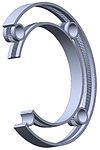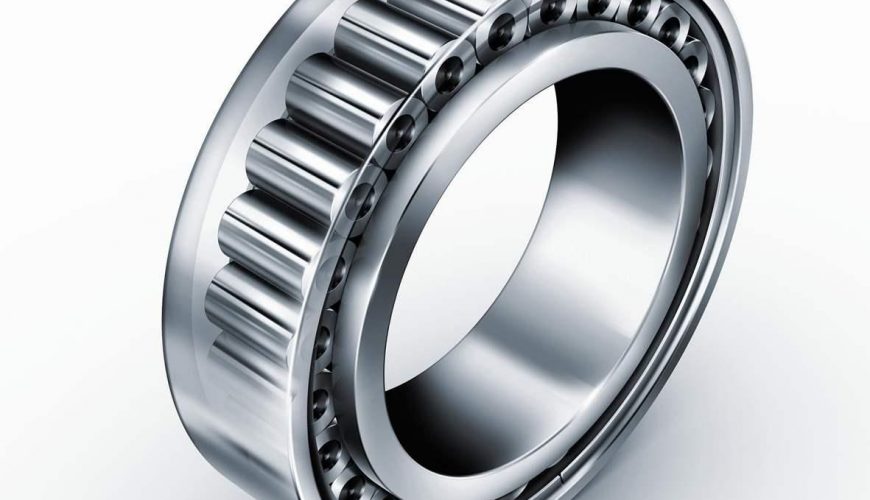There are five types of rolling elements that are used in rolling-element bearings: balls, cylindrical rollers, spherical rollers, tapered rollers, and needle rollers.
Most rolling-element bearings feature cages. The cages reduce friction, wear, and bind by preventing the elements from rubbing against each other. Caged roller bearings were invented by John Harrison in the mid-18th century as part of his work on chronometers.
Typical rolling-element bearings range in size from 10 mm diameter to a few metres diameter and have load-carrying capacity from a few tens of grams to many thousands of tonnes.
Roller bearings

Load distribution (normal force per roller) in a cylindrical roller bearing of type NU206. The inner ring and rollers of the bearing rotate counterclockwise; a static radial load of 3,000 N acts on the inner ring in the downward direction. The bearing has 13 rollers, 4 of which are under load at all time.
Cylindrical roller

A cylindrical roller bearing Roller bearings are the earliest known type of rolling-element-bearing, dating back to at least 40 BC. Common roller bearings use cylinders of slightly greater length than diameter. Roller bearings typically have higher radial load capacity than ball bearings, but a lower capacity and higher friction under axial loads. If the inner and outer races are misaligned, the bearing capacity often drops quickly compared to either a ball bearing or a spherical roller bearing.
As in all radial bearings, the outer load is continuously re-distributed among the rollers. Often fewer than half of the total number of rollers carry a significant portion of the load. The animation on the right shows how a static radial load is supported by the bearing rollers as the inner ring rotates.
Spherical roller

A spherical roller bearing Main article: Spherical roller bearing
Spherical roller bearings have an outer ring with an internal spherical shape. The rollers are thicker in the middle and thinner at the ends. Spherical roller bearings can thus accommodate both static and dynamic misalignment. However, spherical rollers are difficult to produce and thus expensive, and the bearings have higher friction than an ideal cylindrical or tapered roller bearing since there will be a certain amount of sliding between rolling elements and rings.
Gear bearing

Main article: Gear bearing Gear bearing is roller bearing combining to epicyclical gear. Each element of it is represented by concentric alternation of rollers and gearwheels with equality of roller(s) diameter(s) to gearwheel(s) pitch diameter(s). The widths of conjugated rollers and gearwheels in pairs are the same. The engagement is herringbone or with the skew end faces to realize efficient rolling axial contact. The downside to this bearing is manufacturing complexity. Gear bearings could be used, for example, as efficient rotary suspension, kinematically simplified planetary gear mechanism in measuring instruments and watches.
Tapered roller

A tapered roller bearing Main article: Tapered roller bearing
Tapered roller bearings use conical rollers that run on conical races. Most roller bearings only take radial or axial loads, but tapered roller bearings support both radial and axial loads, and generally can carry higher loads than ball bearings due to greater contact area. Tapered roller bearings are used, for example, as the wheel bearings of most wheeled land vehicles. The downsides to this bearing is that due to manufacturing complexities, tapered roller bearings are usually more expensive than ball bearings; and additionally under heavy loads the tapered roller is like a wedge and bearing loads tend to try to eject the roller; the force from the collar which keeps the roller in the bearing adds to bearing friction compared to ball bearings.
Needle roller

A needle roller bearing Main article: Needle roller bearing
Needle roller bearings use exceptionally long and thin cylinders. Often the ends of the rollers taper to points, and these are used to keep the rollers captive, or they may be hemispherical and not captive but held by the shaft itself or a similar arrangement. Since the rollers are thin, the outside diameter of the bearing is only slightly larger than the hole in the middle. However, the small-diameter rollers must bend sharply where they contact the races, and thus the bearing fatigues relatively quickly.
CARB toroidal roller bearings
CARB bearings are toroidal roller bearings and similar to spherical roller bearings, but can accommodate both angular misalignment and also axial displacement. Compared to a spherical roller bearing, their radius of curvature is longer than a spherical radius would be, making them an intermediate form between spherical and cylindrical rollers. Their limitation is that, like a cylindrical roller, they do not locate axially. CARB bearings are typically used in pairs with a locating bearing, such as a spherical roller bearing. This non-locating bearing can be an advantage, as it can be used to allow a shaft and a housing to undergo thermal expansion independently. Toroidal roller bearings were introduced in 1995 by SKF as “CARB bearings”. The inventor behind the bearing was the engineer Magnus Kellström.


